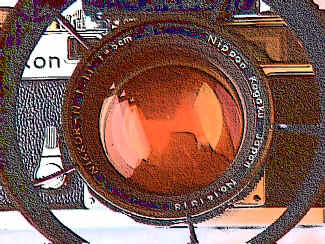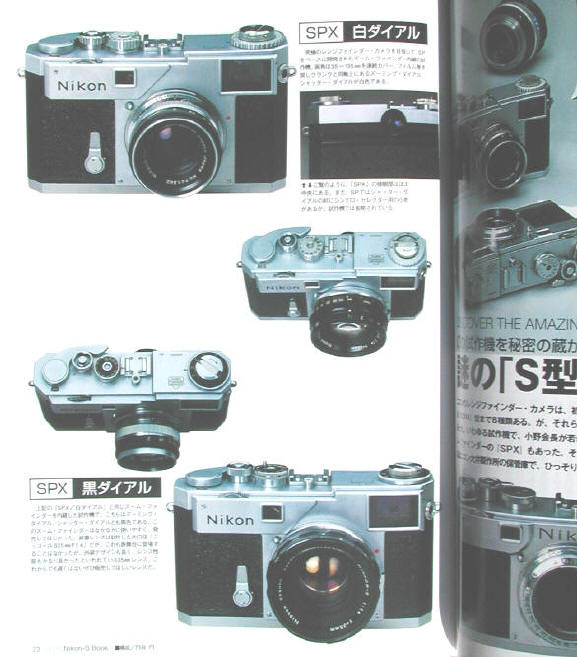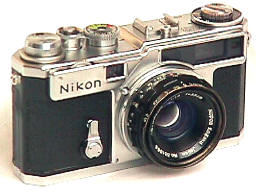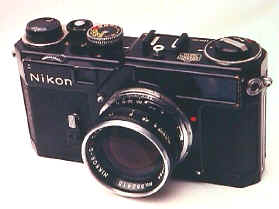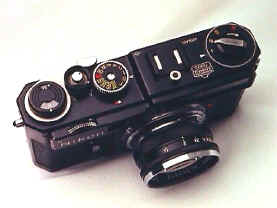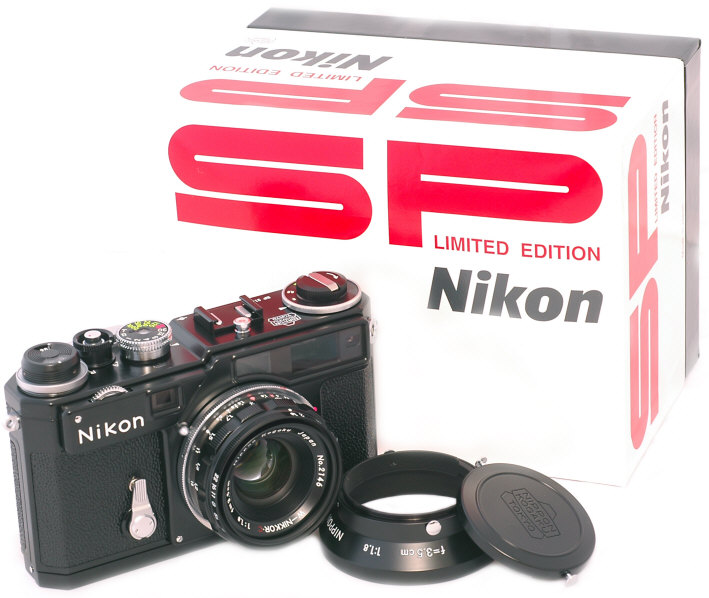The SP has a very nice feel to it, every bit competitive
to the M3. The Leica has a brighter RF/VF, but the SP is easier and faster to load
and rewind. The SP's finish was beautiful. It's a pity that few mint cameras
remain. If you see a tired worn SP sitting on a shelf, realize its only a shadow of its
once beautiful self. As great as the SP's finish was, Leica and Contax edged it out finish
wise, but the SP edged out the Canons.
The focusing wheel just behind
"Nikon" focuses the 50/2, 50/1.4, 25/4, 28/3.5, 35/3.5 and
35/2.8. The other lenses are focused by turning their lens
barrels. The little metal tab just in back of the focusing wheel is the infinity
lock for those lenses. Push it and it unlocks. The shutter speed dial
is a single non-rotating dial, just like on the later F's. Pull up and
rotate the shutter speed dial to set the sync for electronic flash or flash
bulbs. You use the color codes in the little window in front of the
dial. In the pic it's set to the red dot, a flash bulb setting. For
flash, set it to "FX" and use a shutter speed of 1/60th or slower.
Notice the "A" and the "R" in front of the shutter release.
By turning the shutter release collar, you set the camera to advance or
rewind the film. The film counter is automatic, but you do manually set the
reminder for 20 or 36 exposures. Shown mounted is the hard to find and sharp black
85/2 Nikkor.
Time has proven the SP shutter more reliable than the
Leica or Contax. Nine out of ten Leica rangefinders (M's or screw mounts)
rescued from retirement closets after 30 years need shutter work. Inaccurate
or inoperative slow speeds are VERY common with ANY Leica rangefinder sitting for
years without regular shutter exercise. If sitting for decades in their
retirement closet, about 10% need their cloth shutter curtains replaced
too. In contrast, Nikon SP's stored under the identical
conditions usually have no need of shutter repairs or adjustments.
I have never had to replace a Titanium Nikon shutter curtain.
Bob Rotoloni, in his superb book Nikon Rangefinder
Camera, states that 22,348 SP's were produced from 1957 to 1962. To put this in
perspective, about 165,000 total Nikon Rangefinders were made, about 950,000 Nikon F's
were made, and about 225,000 Leica M3's were made. The SP is a relatively rare camera,
sought by users and collectors alike. The rarest SP are the black ones, originally sold
just to photojournalists. Occasionally you will see SP's with serial numbers
ranging in the 30,000 range or over. These are cameras with replacement top plates.
About the first SP's 14,000 had cloth shutters. The
remaining production used titanium shutter curtains of the just introduced Nikon F.
Today the Titanium shutter SP's sell for more than the cloth curtains.
The cloth shutters are a bit quieter to my ears, but the Titanium is undeniably more
durable. The SP's larger shutter speed dial is easier to change than the smaller dial on
the Leica M's.
The later titanium shutter SP's share some parts with the
Nikon F, namely the lever advance, the self timer, and the film counter cover.
The interesting part of this is that these shared parts ARE NOT the first series of
F parts. Try to figure that one out!
The Nikon SP is superior to the Leica M's when it comes
to using sync cords. SP's use a standard PC terminal, placed out of the
way on the camera's front left edge. Here it won't easily end up in the
photogs eye, like the Leica M design. M3's & M2's used a non standard sync
outlet which was a bit of a pain. Later Leica went with the standard sync outlet,
but in the same location which is easily in your way.
Nikon optics of the era had a much harder front coating
than Leitz. You will very seldom find cleaning marks on Nikon
Rangefinder Lenses. In contrast, cleaning marks are very common on Leitz lenses of the
same era. Likewise, Nikkor lenses are usually clear as bell after decades of storage.
Leitz lenses of the 50's and 60's are often very foggy after years of storage due to the
condensation of the lubricant they used. According to Don Chatterton, this is due to the
sperm whale oil lubricant Leitz used at the time.
The SP, as well as all Nikon Rangefinders, used a
modified Zeiss Contax Rangefinder mount. Nikon tried to copy it exactly, but failed
in that the Nikon helical thread is a slightly different pitch than Contax. It
was 1946, and the B-29's had left few precision measuring instruments in their wake.
While wide angle lenses can be interchanged between the two systems, the
difference in focusing starts to show up in the 85's and longer. Some authors claim that
the Contax mount is inherently weaker and more trouble prone than Leica's. I don't agree.
While the helical built in the body does require a lube from time to time, so does the
helical for Leica's lenses. I consider it a draw on this point since both require
occasional maintenance.
The Nikon/Contax RF mount is peculiar in having the
focusing helical for 50 mm lenses built into the camera body and focused with
a rotating wheel which falls neatly beneath the right index finger. All other lenses
except for the 25 are designed to be focused using their own helical. The focus wheel for
the 50 takes a bit of getting used to, but is not inconvenient. The focus wheel can be
dispensed with by turning the 50's own barrel if you like. Mount
wide angle and telephoto lenses by turning the focusing mount AND the lenses back to
infinity.
You might be surprised if you ever compare a 50/1.4 Nikkor mounted on a SP,
side by side to a 50/1.4 Summilux on a M6. The Leica lens is about 3 times larger!
The SP wins the light compact 50/1.4 race.
While some will argue superiority between the
Leitz/Nikon/Contax/Canon lenses of this era,
my experience found very little difference between them using
medium or fast films in hand held shooting. They will all give great
professional results--just as you would expect of professional quality cameras.
